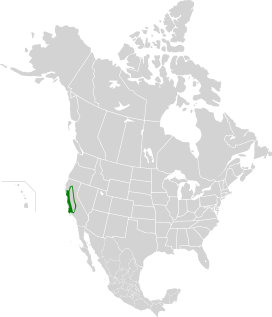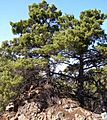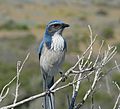California interior chaparral and woodlands facts for kids
Quick facts for kids California interior chaparral and woodlands |
|
|---|---|

Hillside in Sunol Regional Wilderness, April 2004
|
|
 |
|
| Ecology | |
| Realm | Nearctic |
| Biome | Mediterranean forests, woodlands, and scrub |
| Borders |
List
|
| Bird species | 231 |
| Mammal species | 78 |
| Geography | |
| Area | 64,600 km2 (24,900 sq mi) |
| Country | United States |
| State | California |
| Conservation | |
| Conservation status | Vulnerable |
| Global 200 | Yes |
| Habitat loss | 12.915% |
| Protected | 18.35% |
The California interior chaparral and woodlands is a special natural area, or ecoregion. It covers about 64,600 square kilometers (24,900 square miles). This area forms a ring around California's Central Valley.
You can find this ecoregion on hills and mountains. These areas range from about 90 meters (300 feet) to 900 meters (3,000 feet) high. It is part of a biome called Mediterranean forests, woodlands, and scrub. This means it has cool, wet winters and hot, dry summers. Many plants and animals here are used to fires happening now and then.
Contents
Where is this Ecoregion?
This ecoregion stretches across a large part of California. It goes from Shasta Lake in the north to the Santa Barbara Channel in the south.
Even though it's called "interior," parts of this ecoregion are along the coast. You can find it near towns like Goleta and San Simeon. It also includes areas around Monterey and the San Francisco Bay. Higher mountains like the Santa Cruz and Santa Lucia Mountains have different types of forests.
Many big cities are located within this ecoregion. These include Santa Maria, San Luis Obispo, Salinas, and San José. Other cities are San Francisco, Oakland, Santa Rosa, and Redding.
Amazing Plant Life
This ecoregion has many different kinds of plants. You can find grassy areas and chaparral shrublands. There are also savannas with scattered oak trees. Other areas have oak woodlands and unique serpentine soil communities.
You might also see closed-cone pine forests and small patches of mountain conifers. Wetlands, marshes, and riverside forests add to the variety.
The most common plant areas are chaparral and oak woodlands. Chaparral is made up of many different shrubs and herbs. These include chamise, manzanita, and ceanothus. Sometimes, gray pine trees grow among the shrubs.
Buckeye trees are also common. Many types of oak trees grow here, like blue oak. Other oaks include scrub oak, coast live oak, canyon live oak, valley oak, and interior live oak.
Some areas have special serpentine soil. Here, you find unique pine and cypress trees. These include Sargent cypress and MacNab cypress. Many rare plants, like milkwort jewelflower, grow only in these spots.
Cool Animals
More than 70 types of mammals live in this rich ecoregion. Three kinds of kangaroo rats are found only here. Over 100 bird species also make their home in this area.
Some common birds you might see are scrub jays, acorn woodpeckers, and wrentits. These birds help scientists understand the health of the ecoregion.
Protecting this Special Place
Sadly, only about one-third of the original habitat is left. Most of what remains is in higher elevation areas. Trees in Closed-cone pine forests need fire to grow. Their cones open and release seeds after a fire's heat.
When fires are stopped too much, these forests cannot renew themselves. This makes it harder for them to survive.
Many areas in this ecoregion are protected. These include American River Parkway and Berryessa Snow Mountain National Monument. Other protected places are Point Reyes National Seashore and Mount Tamalpais State Park. You can also find Mount Diablo State Park, Henry W. Coe State Park, and Pinnacles National Park. Finally, Folsom Lake State Recreation Area and Carrizo Plain National Monument help protect this unique environment.
Images for kids








